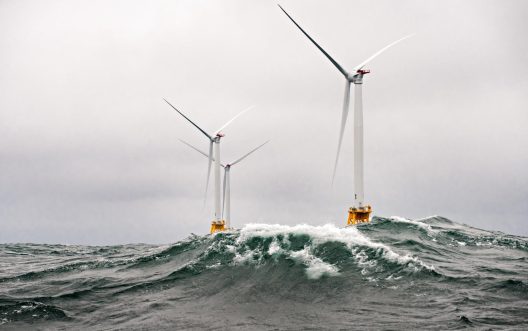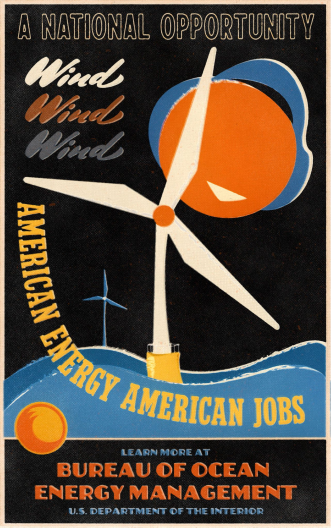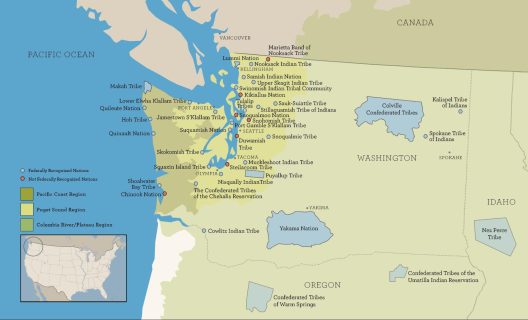Fair Winds and Following Seas: Is Equity in the Breeze?
The authors of this piece recently attended the Northwest Offshore Wind Conference in Portland, Oregon. The Ocean NEXUS Center supported the trip. This piece reflects on lessons learned from that conference.
As offshore wind technology and projects have expanded over the last 30 years, the promised benefits from the technology are becoming clear. Ørsted, the world’s largest offshore wind company, propped up its first turbines with the approval of the Danish government in 1991. Today, huge autonomous monoliths churn away off the shores of Scotland, Denmark, Norway, Germany, China, and Britain, providing over 63 Gigawatts (GW) of global energy capacity. Remarkably, 21 GW of this capacity was erected within the year 2021 alone. These efficient marvels, some as tall as the Eiffel Tower, produce energy without the need for fossil fuel production or consumption. As hurricanes intensify, droughts worsen, and extreme weather events driven by fossil fuel combustion mount, society is rapidly pivoting toward an energy system underpinned by wind and solar energy to mitigate damages caused by the existential calamity of climate change.

The towering offshore wind arrays are juxtaposed with the rampant mass human exploitation and environmental destruction that the oil industry has left behind. Superfund sites scattered across America’s oil refineries and derelict oilfields remind us that a just energy transition is not only new green energy jobs, but a socially inclusive decision-making process that reduces inequities and prioritizes populations that have been disproportionately impacted by environmental and socioeconomic injustices.
To avoid an unbridled rush to build and all its unexpected consequences, our leaders must move carefully and prioritize reducing environmental degradation and the extraction of wealth from local communities. One of the most famous examples of environmental injustice was caused by the rush to exploit petrochemicals in Louisiana, which resulted in over 300 refineries and chemical plants along the shores of the Mississippi River. The legacy of “Cancer Alley” haunts these Mississippi River communities, and the environmental racism thrust upon the area has left it saddled with poverty, air pollution, and cancer. Huge infrastructure changes can transform communities for better or worse. To ensure that the injustices wrought by prior energy transitions are not repeated, we need a just energy transition that includes impacted communities in the decision-making process.
A just transition requires a more inclusive process between regulators, companies, politicians, Tribes, and communities. In the U.S., the Bureau of Ocean Energy Management (BOEM) has initiated the permitting process for projects on the Pacific Coast, starting with California. California aims to build three to five GW of offshore wind energy by 2030, and the Biden-Harris Administration aims for 15 GW by 2035. The mechanism for providing resources and stakeholder engagement from the public is driven by the public comment period within the BOEM leasing and permitting process, allowing local communities to help shape their futures. As the U.S. begins this energy transition, an unprecedented effort to have inclusive negotiations with workers, Tribes, and impacted communities has begun.
Workers and Just Transition
According to the International Labor Organization:
“A Just Transition means greening the economy in a way that is as fair and inclusive as possible to everyone concerned, creating decent work
opportunities, and leaving no one behind. A Just Transition involves maximizing the social and economic opportunities of climate action,
while minimizing and carefully managing any challenges – including through effective social dialogue among all groups impacted, and
respect for fundamental labor principles and rights.”
Offshore wind projects in the Pacific Northwest will likely positively and negatively impact stakeholders from many different communities and backgrounds, particularly those who physically work on them. Such development projects significantly impact workers that are new to the workforce, workers displaced by these projects, and workers transitioning from existing jobs into the offshore wind industry. As part of an inclusive and just process people from these jobs should be included in the decision-making process. A just transition framework attempts to ensure that workers are included.
Predicting the scale and scope of impact upon workers is challenging without established development plans and commitments to wind supply chain solutions. However, it is possible to identify many of the potentially impacted jobs based on supply chain analysis and state government reports. Washington State is currently positioning itself as a potential offshore wind supply chain center, so it is likely that dock workers, maritime workboat crews, truck drivers, electrical workers, and potentially aerospace workers could be impacted by offshore wind. Their livelihoods could be disrupted due to increased training demands, changes in the use of industrial spaces, or alterations to job duties. Since there is a potential for these workers to be displaced or have their jobs altered during offshore wind development, they are important stakeholders to include in discussions. If the transition to renewable offshore energy is to be considered sustainable for both people and the environment, then it is imperative to assess the potential impacts of offshore wind projects through the lens of a just transition.
The just transition discussion is often discussed from the point of view of existing workers in the oil and gas industry. While oil and gas workers will indeed be directly impacted by efforts to reduce carbon emissions, it’s crucial that we recognize that they are not the only workers who will face considerable alterations to their daily lives and careers. At this time, it is hard to know exactly how many new jobs will be created by offshore wind development, but any workplace that will be impacted by renewable development should be included as part of a just transition framework that includes workers, Tribes, and coastal communities.

Tribal Energy Relations
At the Northwest Offshore Wind Conference, panelist after panelist shared a sentiment that is integral to a just transition; “We need to consult with Tribes.”
As a tribal member myself, I looked at my fellow graduate students, Kurt Ellison and Will Kammin with a raised eyebrow and exasperated grin. The three of us knew the importance of engaging Tribes and “stakeholder” communities. What the numerous speakers did not mention is that in the same week of this conference, the National Congress of American Indians (NCAI) issued a moratorium “seeking a halt to all scoping and permitting for offshore wind projects until there is a ‘comprehensive and transparent procedure’ in place that would adequately protect Tribal environmental and sovereign interests.” Another glaring detail was the fact that, in this room of 250+ people, there were exactly three Tribal members: The Confederated Tribe of Coos Bay, Lower Umpqua, and Siuslaw’s (CTCLUSI) Councilman Doug Barrett, CTCLUSI’s previous natural resource director, and me. This stark difference in representation prompts the question “What is their version of consultation?”
In my experience, “consultation” is too often a check box that companies, organizations, and government agencies have placed on a form somewhere as an afterthought. This really undermines what consultation is supposed to perform. Consultations should be exercises in relationship building. They are supposed to strengthen ties and benefit both parties.
The NCAI loosely defines consultation as specific actions that developers and the federal government must take:
“Incorporating Tribal Indigenous Traditional Ecological Knowledge, through co-management of traditional lands and the associated life forms
…these policies must apply to energy development projects that may impact their traditional territories, cultural resources, or sacred sites;
Tribal Nations must be included in the management, permitting, and development of power purchase agreements and both consulted and
included in determining the terms and conditions of the agreements.”
It’s not just coastal Tribes that need a seat at the table — any and all river Tribes that rely on the oceans’ bounties also deserve decision-making opportunities. There are 29 federally recognized Tribes in Washington state, compared to just nine in Oregon. If state and federal bureaus sincerely want to engage Tribes in consultation, a great starting point is considering traditional ecological knowledge and how it can be incorporated into existing practices. In addition, Tribes need to be central in both decision-making and management. They are sovereign nations and should be negotiated with as such.

Community benefits in the era of offshore wind – Does big money mean big benefits?
Community Benefit Agreements (CBAs) are contracts between developers, the government, Tribes, and communities who will be impacted by infrastructure projects. CBAs are meant to mitigate harms and provide specific amenities to reduce the burden infrastructure projects create within impacted communities. The primary example of CBAs in offshore wind in the U.S. was negotiated before California’s first wind energy area bids. California’s first auction, which took place on December 6, 2022, had five wind energy areas (WEAs) go up for bid, generating over $750 million in revenue for the U.S. Treasury. The state of California effectively lobbied for CBAs, which provide (a) up to 30% of the lease bid as credits for different services, (b) 20% for the workforce and supply chain development, (c) 5% for fishermen/lease area users, and (d) 5% for impacted communities and environments. These credits lowered the initial bid price for developers and will be distributed to community projects after meetings and approval by BOEM and community stakeholders. This has two positive effects: lowered initial capital cost for developers to incentivize bidding and community-centered collaboration to decide what the funds should be used for. North Carolina has a goal of 20% of WEA leases going to workforce and supply chain development.
Without CBAs, profits from offshore wind projects will likely be funneled into the developers’ corporate offices, often in Scandinavia, and other centers of wind energy development. Current CBA funds are not ongoing, and these projects are not necessarily guaranteed to be built. After winning their bids, developers have the right to do geotechnical work and to prepare for Environmental Impact Statements before they receive final approval to build. As we seek to limit the environmental impacts of offshore wind energy we must also look at how many jobs will stay in the community, where workforce training will happen, and how fishers and local communities’ lives will be disrupted by an influx of huge infrastructure, such as the wind turbines, transmission lines, and increased port development. If offshore wind developments aren’t completed, no additional continuing revenues for the communities can be realized, leaving the CBAs goal of ensuring measurable and permanent improvements to the lives of affected communities unmet.
The opportunity to continue funding within communities comes when it is time to connect these wind farms to the grid. States have the right to bargain for interconnection fees or provide energy subsidies for local residents. The Reinvesting in Shoreline Economies and Ecosystems Act has been introduced to create a new stream of funding from offshore wind projects. It eliminates a cap on state revenue sharing and sets the amount of shared revenues for offshore wind farms at 50%. These funds can be used to implement marine and coastal management plans, fund restoration, and mitigate damage to fish, wildlife, and other natural resources. Much of the future depends on the politics and policies that we build throughout the present decade, and the equity implications are massive with potentially trillions of dollars at stake. It is time to employ tools that empower affected communities during this energy upheaval so community priorities set the agenda on the path to a just energy transition. No longer will the edicts of government and corporations alone dictate America’s infrastructure development. A new era has begun, where workers, Tribes, and communities can use CBAs and mandates of environmental justice to steer offshore wind development funds toward good jobs, affordable housing, and community services that improve the quality of life for all our nation’s citizens.